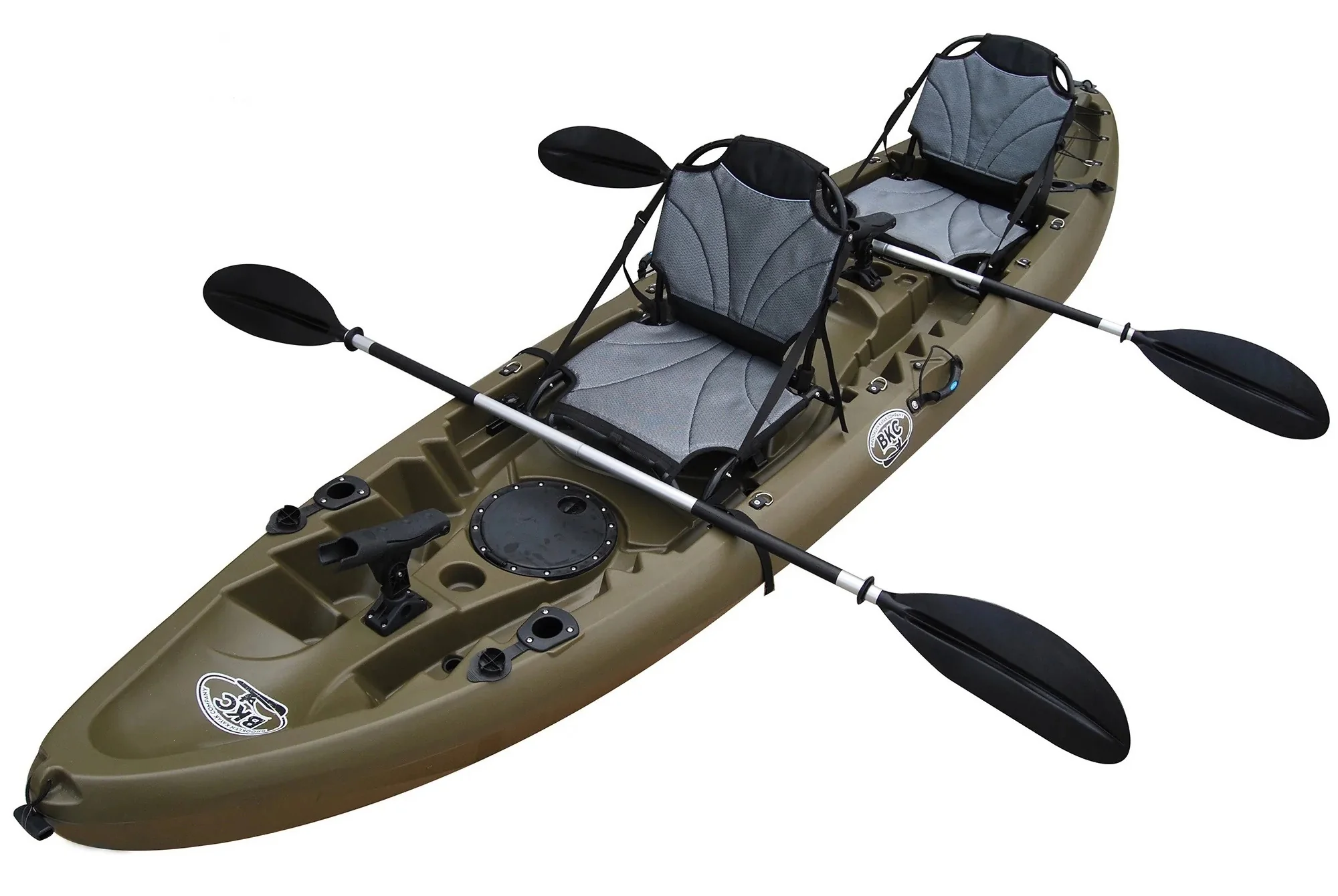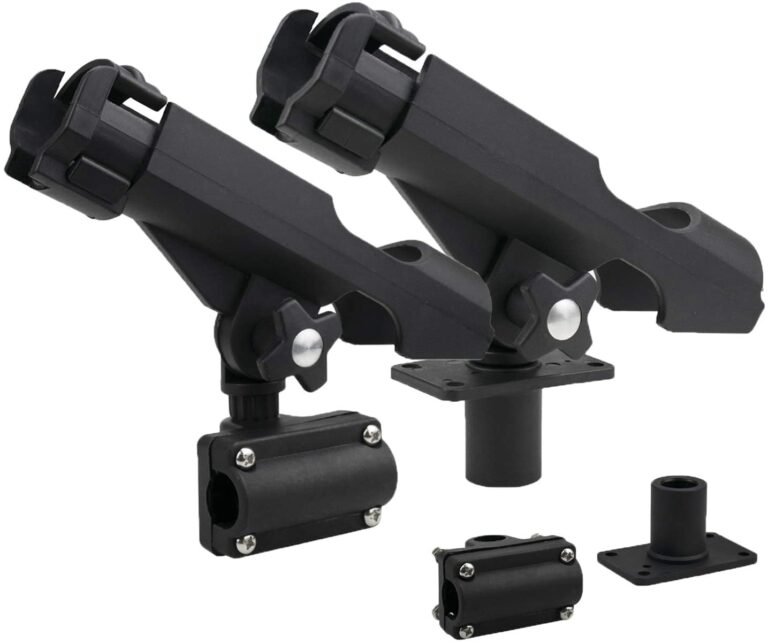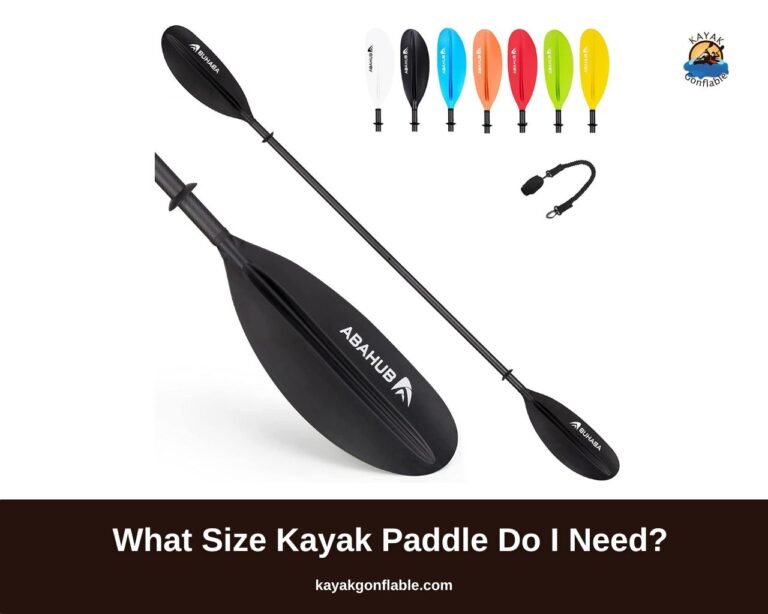What Is A Tandem Kayak?

Various types of boats can travel across the water. Kayaks are one of the boat types. There is a solo kayak that can accommodate only one kayaker.
A tandem kayak, as the name suggests, is a kayak built for two paddlers. Unlike traditional solo kayaks, which are designed for a single person, tandems feature a longer hull to accommodate two individuals comfortably.
They come in various shapes, sizes, and designs. From sit-on-top kayaks, which are ideal for recreational use to sit-inside kayaks, which are suitable for touring and exploration.
Tandem kayaking offers unique experiences that set it apart from solo kayaking. Some key reasons why many kayakers choose to paddle tandem include:
- Teamwork: Tandem kayaking requires effective communication and teamwork, fostering cooperation and trust between paddlers.
- Shared Adventure: Tandem kayaking allows you to share the adventure with a partner, creating memorable experiences and bonding moments.
- Increased Force: With two paddlers, you can generate more force and speed, making it easier to tackle challenging waters.
- Balanced Effort: Coordinating your strokes with a partner can result in smoother and more efficient paddling, enhancing your overall kayaking experience.
How Tandem Kayaks Work
Paddling in Sync
A tandem kayak functions differently than a solo kayak. You must paddle together at all times. When you both paddle simultaneously, the tandem kayak speeds up. Compared to a solo kayak, tandem kayak speed is high, especially when you both paddle in unison.
Paddling in unison also helps to avoid paddle collisions. The proximity of the paddlers within the kayak can also cause you to hit your partner’s paddle, causing you to lose sync. As a result, you should always time your strokes.
Who Controls The Rhythm?
The paddler in the front controls the rhythm. If you sit in front, you have control over the rhythm. Because you can’t see your partner behind you, but they can see your movements more clearly. Your partner should follow your paddling movements from the back.
When you’re in the lead, make sure your movements are quick, concise, and even. Notify your partner when you need to steer the kayak.
Otherwise, you’ll all lose your balance, and everything will be a mess! You should also let your travel companion decide and suggest your route. Don’t be selfish!
Are You the Experienced Paddler? Sit at the Back
You should sit in the back if you are an experienced or strong partner. You can easily change the pace as a skilled or physically strong kayaker by sitting in the back. You’ll also be able to track their strokes easily.
Paddling for an extended period can also exhaust your partner. Especially newbies. They’ll certainly want to take a break. When you’re strong enough, you’ll take control of the boat. You must continue paddling, which is simple while sitting in the back.
Turning A Tandem Kayak
Turning a tandem is more complex than turning a solo kayak. But the best thing about having you two on a tandem kayak is that you only need to work together. Communicate.
Even if your partner is new to the team, communicate with them so they can learn what they need to do. With both of you knowing what to do, the boat will be much easier to control. What is the best way to turn your tandem? Who is in the front row? You? Fine.
If you’re sitting in the front, perform a forward sweep on one side while your partner does a reverse sweep on the other. And all at the same time. You’ll turn the kayak swiftly, especially when it’s stationary.
A Tandem kayak also has a rudder that you can use to turn. The rudder keeps the boat on course without needing extra, energy-draining corrective strokes. But it is less used when you’re working as a team.
What Materials Are Tandem Kayaks Made of?
These kayaks are made using different materials, each offering its own unique advantage in terms of durability, weight, and performance. Some common materials used in the construction of tandem kayaks include:
- Fiberglass: Fiberglass kayaks are known for being lightweight and having excellent performance. They provide a good balance between weight and durability, making them a preferred choice for those seeking efficiency in their tandem kayaks.
- Polyethylene (PE): PE is a popular choice for its durability and affordability. Kayaks made from polyethylene are rugged and can withstand bumps and scrapes. The only downside? They tend to be heavier than other materials.
- Inflatable (PVC or Hypalon): Inflatable tandems are highly portable and easy to store. They are typically made from PVC or Hypalon materials, which are rugged and resistant to punctures. While they may not offer the same performance as hard-shell kayaks, they excel in terms of convenience and transportability.
- Composite Materials (Carbon, Kevlar): Composite tandems are the lightest and often the most expensive. They offer exceptional strength-to-weight ratios, making them popular among serious paddlers and enthusiasts.
Pros of Tandem Kayaks
Stability
If you’re looking for stable water recreation activity, a tandem kayak is a way to go. The kayak promises stability from its high weight. They’re more stable than single kayaks. Furthermore, they are wide, which means the bigger the surface area.
Best for Newbies
Want to learn how to kayak? Your best option will be a tandem kayak. You can easily train or teach your partner to paddle with a tandem kayak.
Look for an experienced partner. You must stay in front while your experienced partner guides and leads you to paddle from behind.
Time Spent in a Tandem Kayak Means Fun.
A tandem allows you to go kayaking with your partner. You get to spend time together while admiring nature’s beauty. This is also possible with solo kayaks. A tandem kayak is unique in that you will bond in the process of learning to work simultaneously or as teamwork.
You Can Take Turns Paddling
A tandem kayak, as opposed to a solo kayak, allows you to take a break from paddling for an extended period. You and your partner can paddle the kayak in turns.
You Can Easily Convince Your Friend To Try Kayaking
You can persuade your friend to go kayaking with one extra spot. Your friend is welcome to join you on the kayaking trip. Even if they have no prior experience, they will trust you to teach them how to paddle.
Cons of Tandem Kayaks
Often Arguments
You’ll certainly disagree with your partner, especially when choosing travel routes. You may also find it challenging to enjoy your kayaking and the beauty of nature when you have someone to train and who is constantly talking to you.
Tandems are larger than solo kayaks, with the average one measuring 17 to 24 feet in length. The tandem kayak can hold two people. That being said, going kayaking with your significant other is an excellent choice with a tandem kayak.
You and your partner must paddle in unison for your tandem kayak to move quickly. Simultaneous paddling speeds up the kayak.
Types of Tandem Kayaks
Sit-in Kayaks: These kayaks have enclosed cockpits with seats inside. They offer better protection from the elements and are suitable for cooler climates or situations where you want to stay dry. Sit-in tandems are versatile and can be used for recreational paddling, touring, and even mild whitewater.
Sit-on-Top Kayaks: Sit-on-top tandems have open cockpits with molded seats on top of the kayak. They are perfect for warm-weather paddling as they allow you to stay cool and provide easy access to the water. Sit-on-top tandems are often used for recreational paddling, fishing, and family outings.
Inflatable Kayaks: Inflatable tandems are highly portable and convenient. They are excellent for travelers, as they can be deflated, packed into a compact bag, and easily transported.
Hard-Shell Kayaks: Hard-shell tandems are made from rigid materials such as polyethylene, fiberglass, or composite materials. They offer superior performance, efficiency, and durability. They are suitable for more advanced kayakers and a wider range of activities, including touring, sea kayaking, and whitewater paddling.
Fishing Kayaks: These tandems are designed specifically for anglers. They often feature fishing-friendly accessories like rod holders, storage for tackle, and comfortable seats for long days on the water. Fishing tandems are typically sit-on-top kayaks, providing anglers with stability and easy access to fishing gear.
Touring Kayaks: Touring tandems are built for longer journeys and open-water exploring. They have sleek designs and offer excellent tracking and speed. They are often equipped with storage hatches and bulkheads to carry gear and supplies for multi-day trips.
Anatomy of a Tandem Kayak
Hull: The hull is the kayak’s body, the part that comes into contact with the water. It determines the kayak’s stability, speed, and maneuverability. Tandem kayaks can have different hull shapes, such as flat-bottomed for stability or V-shaped for better tracking and speed.
- Length: Tandem kayaks are typically longer than single-seat kayaks, ranging from 17 to 24 feet or more. The increased length enhances stability and speed.
- Width: The width of the hull affects stability. Tandem kayaks tend to be wider than solo kayaks, which enhances stability but may slightly compromise speed.
Cockpit: The cockpit is the seating area where paddlers sit. In tandems, there are two separate cockpits, one for each paddler. The design and layout of the cockpits can vary depending on the kayak’s purpose.
- Seating: Tandems have two separate seating areas, each equipped with a seat for a paddler. These seats may have adjustable backrests and padded cushions for comfort during extended paddling sessions.
Deck: The deck is the top part of the kayak that covers the hull. It often includes features like storage hatches, bungee cords for securing gear, and handles for easy carrying.
Footrests or Foot Pegs: These are adjustable footrests inside the cockpit that provide a point of contact for the paddlers’ feet. Properly adjusted footrests aid in maintaining balance and support efficient paddling strokes.
Skeg or Rudder: Many tandems are equipped with a skeg or rudder system to aid in steering. These components can be controlled by one or both paddlers to maintain a straight course or navigate effectively.
Storage Hatches: Tandem kayaks often have multiple storage hatches built into the deck. These watertight compartments allow paddlers to store gear, clothing, and supplies securely.
Tandem Kayaking Guide
Tandem kayaking opens up a world of adventure and connections. Whether you’re embarking on this journey with a partner, friend, or family member, proper preparation and techniques are essential for a safe and enjoyable experience.
Important Prep For Your Adventure
Safety Considerations
Safety should always be a top priority when kayaking. Here are some essential safety considerations:
- Life Jackets: Ensure that both paddlers wear properly fitting and Coast Guard-approved life jackets at all times.
- Communication: Establish clear and effective communication between paddlers. Discuss hand signals or verbal cues to coordinate strokes and maneuvers.
- Float Plan: Let someone on shore know your planned route and estimated return time.
- Weather Check: Check the weather forecast before heading out, and be aware of changing weather conditions on the water.
- Paddle Responsibly: Respect local regulations, navigation rules, and wildlife. Avoid disturbing sensitive habitats.
Gear and Equipment Needed
Before you hit the water, make sure you have the following gear and equipment:
- Your Tandem Kayak: Ensure your kayak is in good condition, with no leaks or structural issues.
- Paddles: You’ll need two paddles, one for each paddler. Choose paddles of appropriate length and type (e.g., touring, whitewater, or recreational) for your intended activity.
- life jackets: As mentioned earlier, wear properly fitting and approved life jackets.
- Safety Gear: Pack essentials like a whistle, a bilge pump or sponge to remove water from the kayak, a first aid kit, and a rescue rope.
- Navigation Tools: Carry a map, compass, or GPS device to help you navigate if you’re exploring unfamiliar waters.
- Dry Bags: Use dry bags or containers to keep your gear, clothing, and valuables dry.
- Sun Protection: Wear sunblock, sunglasses with UV protection, and a wide-brimmed hat to shield yourself from the sun.
How To Launch Your Tandem Kayak
Launching your kayak can be tricky, but with practice, it becomes second nature. Here are some useful steps to follow:
- Prepare the Kayak: Ensure all gear is secured, and the kayak is properly loaded with even weight distribution.
- Launch Site: Find a gentle and stable shoreline for launching. Avoid steep banks or rocky areas that may cause accidents.
- Enter The Kayak: Both paddlers should stand on either side of the kayak, holding the paddle horizontally across the kayak to provide stability.
- Push Off: Gradually push the kayak into the water while stepping in. Sit down one at a time, ensuring stability before starting to paddle.
How To Tandem Kayak: Basic Paddling Techniques
Proper paddling techniques are essential for an efficient and enjoyable kayaking experience. Here are some basic techniques to keep in mind:
- Synchronize Your Strokes: Coordinate your paddling strokes with your partner to maintain a straight course. Communication is key to achieving synchronization.
- Steering: If your kayak is equipped with a rudder or skeg, discuss how to control it with your partner. Usually, one paddler manages the steering while the other focuses on propulsion.
- Maintain Posture: Sit with your back straight and knees bent. Use your core muscles for paddling power rather than just your arms. Keep a relaxed grip on the paddle.
- Avoid Overexertion: Paddling in tandem should be a harmonious effort. Avoid paddling too forcefully, as this can lead to fatigue and discomfort.
- Practice Maneuvers: Familiarize yourselves with basic maneuvers like turning, stopping, and reversing. Practice these in calm waters before attempting more challenging environments.
Proper Kayaking Etiquette
Proper etiquette is not only a matter of courtesy but also essential for safety and environmental conservation. Here are some etiquette guidelines for kayakers:
- Right of Way: When sharing the water with other vessels, understand the right of way rules and adhere to them. Generally, slower-moving vessels yield to faster ones.
- Maintain Distance: Keep a respectful distance from other kayakers, and boats. Avoid approaching too closely, as it can be disruptive and potentially dangerous.
- Pack Out What You Bring: Practice “Leave No Trace” principles. Do not litter or leave any trash behind. Bring back everything you bring with you.
- Respect Wildlife: Observe wildlife from a distance without disturbing them. Avoid approaching nesting birds, seals, or other animals.
- Minimize Noise: Keep noise levels to a minimum. Excessive noise can disturb wildlife and disrupt the tranquility of the natural environment.
- Stay Informed: Be aware of any local regulations or specific rules for the waterway you’re kayaking on. Some areas may have specific restrictions or guidelines.
If you’re new to kayaking and want to get started, tandem kayaking is a great way to get started. You’ll need an experienced partner willing to show you how to paddle. In addition, a tandem kayak provides more stability than a solo kayak. You’re now ready to take the water on your new tandem kayak!






